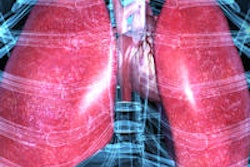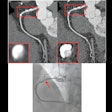Nonsolid nodules detected with CT lung cancer screening are often indolent, and even when they do harbor cancer, the long lead times before such nodules develop make it safe to follow them up less often, according to new long-term data presented at the RSNA 2014 meeting.
The data on more than 57,000 screening participants in the International Early Lung Cancer Action Program (I-ELCAP) -- some of whom have been followed for more than 10 years -- reveal generous lead times and very few cancers over time among nonsolid lesions, especially larger ones, reported lead investigator Dr. Claudia Henschke, PhD, from Weill Cornell Medical College.
So although the follow-up of nonsolid nodules remains a topic of controversy, the new data show there's no rush to rescan nonsolid lesions, especially when they appear on annual repeat screening rounds rather than on baseline CT screening, she said.
"I think cancers in nonsolid nodules are slow-growing," Henschke said in her talk. "Nonsolid nodules of any size can be followed in 12 months."
Object of scrutiny
The U.S. National Cancer Institute (NCI) has been looking at nonsolid lung lesions recently, among a few cancer types, for guidelines on screening and follow-up, she said. Such lesions tend to grow slowly and aren't categorized appropriately with more-aggressive tumor types.
"Nonsolid nodules are such a candidate, and we need to know how frequently they occur, what their natural course is, what workups should be done, and what treatments provided," Henschke said. "These are all questions that need to be answered, and we looked at our large database for the answers."
First, when looking for guidance on creating screening protocols, it's important to separate baseline screening from follow-up rounds, she said.
"When we think about making the recommendations for screening regimens, we always use age, smoking history, and occupational exposure, and we try to integrate the CT findings about emphysema and coronary artery calcifications," she said. "But what is not looked at very carefully is what round of screening is being addressed, and that is really an important part of proper management."
The particular round of screening isn't emphasized in most clinical trials, such as the National Lung Screening Trial (NLST), because the efforts are focused on cancers detected at baseline. These cancers dominate the results in NLST because the study included only two follow-up rounds of screening.
But things are different in clinical practice, where a 50-year-old screening subject might undergo 24 follow-up screening rounds before age 75. As a result, the follow-up screens grow in importance over time.
I-ELCAP logged a total of 57,496 baseline screenings with follow-up, Henschke said. Of these, 4.2% (n = 2,392) showed a nonsolid nodule at baseline. The nonsolid nodule resolved or decreased in size in 26% (n = 628) of cases, and lung cancer was diagnosed in 73.
In contrast, the annual repeat screens revealed only 0.7% (n = 485) with a new nonsolid nodule, and this nodule resolved or decreased in size in 66% (n = 322) of cases. None were found to have lung cancer on follow-up, but lung cancer was diagnosed in 11 (0.017% of 64,677) nonsolid nodules that remained stable or increased in size.
"That gives you a way to look at the lead time that CT screening provides, and if you consider only the diagnosed cancers, then it shows you a lead time of seven years," Henschke said. "If you consider all those nonsolid nodules and cancers, then it would be six years, so there's a long lead time however you want to look at it."
So, relatively speaking, there are far more nodules at baseline, and far fewer at repeat screening, she said. And even though 628 nodules resolved or decreased after the baseline round, the proportion of shrinking or disappearing nodules was much higher on annual repeat scans, where 66% decreased or disappeared.
| Prevalence of malignancy in nonsolid nodules | ||
| Nodule size | Adenoma at baseline | Adenoma at follow-up |
| < 6 mm | 0.6% | 0.9% |
| 6-9 mm | 3% | 3% |
| 12-14 mm | 12% | 6% |
| > 14 mm | 12% | 0% |
"So it's very important to look at the round that you're screening, and to understand what the probabilities of malignancies are," Henschke said.
All cancers in nonsolid nodules were stage I adenocarcinomas, among which 84 cases of lung cancer have been diagnosed to date, Henschke said. Of these, 45 patients underwent lobectomy, one had a bilobectomy, and one underwent radiotherapy. The result is 100% survival, with a mean follow-up since diagnosis of 80 months (range, 4-161 months), regardless of diagnosis, a delay in diagnosis, or the emergence of a solid component to the tumor.
"What are the implications?" she asked.
For one thing, all nonsolid nodules were growing slowly, and all were stage I whether or not they were invasive.
"There was no benefit to early diagnostics or treatment because whenever it was done, the survival rate was still 100%," she said. "We think that nonsolid nodules of any size can be followed in 12 months. The median time to treatment in I-ELCAP was 19 months."
"Currently, CT is the best marker of aggressiveness, and surgical resection is curative despite delays of up to 10 years. And it doesn't matter if it's a lobectomy, sublobar, or resection."
A moderator in the session asked how to communicate with a patient who may have a nonsolid nodule that is a candidate for waiting rather than immediate follow-up. Following the recent recommendations of an NCI panel, Henschke said the physician can use different terms for these nodules, calling them something like "indolent lesions of epithelial origin."
Nevertheless, "we send the report to patients, and you really have to put in the differential [diagnosis] that it could be adenocarcinoma," she said. "These lesions can be followed, and maybe short-term follow-up will reassure a few people, but you don't need to do it."



















